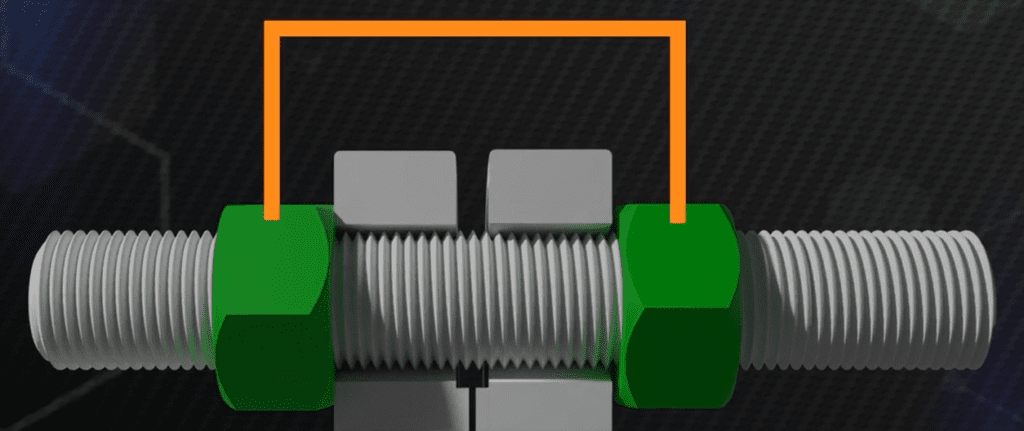Including Pipe Flanges, RTJ’s, Raised Face, and Custom Flanges
Different flange types and sizes require specific stud bolt dimensions. This article will discuss how the stud bolt length can affect flange joint assembly and how to choose the correct studs for your flange type and size.
- What is the Effective Length of Studs?
- How Does the Stud Bolt Length Affect Flange Joint Reliability?
- Standard ASME B16.5 and ASME B16.47 Flange Sizes
- Custom Flanges: Non-ANSI and API Flanges
- How Do I Fix the Stud Bolt Length Ratio to the Diameter of Bolts?
What is the effective length of studs?
The effective length of an ANSI stud bolt is essentially the middle of the nut to the middle of the nut. We call this the “grip length” of a fastener; this is where the majority of bolt load will reside, no matter the diameter of the bolts.
Most people think that the entire hex nut will hold the load, meaning the whole length of the stud bolts is engaged in maintaining load and gasket stress. But again, it is only the middle of the hex nuts to the middle of the hex nuts that do most of the work!

Some people will discuss the Nominal Pipe Size (NPS), the use of metric bolts, the unified coarse pitch threads (UNC) of the bolt (or other thread pitches), or even the fact that it’s a Ring Type Joint (RTJ) instead of a Raised Face Flange affects the flange. And they are correct, but for other reasons.
For example, the 150# flange series are mathematically more likely to leak than the higher ratings found in the ASME B16.5 flange series. Why is this? Not because of the stud length, but because the diameter of bolts found in these flanges is minimal compared to the gasket; therefore, it is really hard to get good gasket stress on these flanges.
FUN FACT #1:
8″ nominal pipe size in the 150# series flanges is mathematically more likely to leak because there is not enough bolt load than any other nominal pipe size or flange size. To increase the gasket stress, you would have to increase the number of studs or the diameter of studs. The length of the stud has very little to do with the reason these are poor-performing flanges!
Fun Fact #2:
3″ nominal pipe size in the 150# series flanges are the second worst for the same reason…low gasket stress. Not because of the length of the stud bolts.
Items not covered in this article are corrosion issues, different ring gaskets, machine bolts, history of ASTM a193, and stainless steel bolt materials compared to B7 bolt materials.
How does the stud bolt length affect flange joint reliability?
Short bolt lengths are typically less reliable than longer bolt lengths. The rule of thumb for a desirable stud length is a 5:1 ratio length of the stud to the diameter of the stud, meaning that the length of the stud bolt is five times larger than the diameter of the stud bolts.
It doesn’t take much deflection when the bolt length is short to relieve the bolt load; however, a longer bolt length with the same spring rate will have to deflect more before the bolt load is lost.
Therefore, when looking at the bolt circle, we want to see the length of stud bolts 5X greater than the bolt diameter.
Standard ASME B16.5 and ASME B16.47 Flange Sizes
When looking at a standard flange (ASME B16.5 or ASME B16.47), we don’t see many flanges where the length of the stud has a ratio of less than 5:1 length of stud to the diameter of the stud. This means that we don’t see this as an issue with these types of flange sizes.
Below is a flange bolt chart that shows that the stud bolt lengths got both ASME B16.5 flanges & ASME B16.47 flanges. It includes the bolt dimensions (including the size of the hex nuts & length of stud bolts), the different lengths of studs needed for RTJ’s and Raised Face Flanges, and the number of fasteners in each flange!

Custom Flanges: Non-ANSI and API Flanges
This becomes more of an issue when we look at custom flanges such as heat exchangers or reactors. As you can see from the video, when we drilled out the threaded tube sheet in the flange, we effectively doubled the length of the stud. Therefore this joint is more reliable when it comes to relaxation.
How Do I Fix the Stud Bolt Length Ratio to the Diameter of Bolts?
Remember, the shorter the bolt, the more deflection and the more “relaxation.”
How do you cure this if you have a short stud bolt length ratio to the diameter of bolts?
There are several options… our favorite is spacers for the bolts. These are the easiest to implement and use in the field. But every bolted flange joint is different, so if you would like more help, please email us at [email protected].
See also:
Relaxation Pass in Bolted Flange Joints


